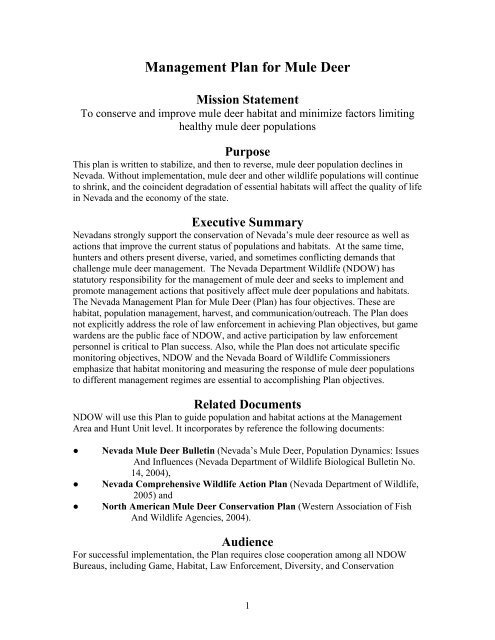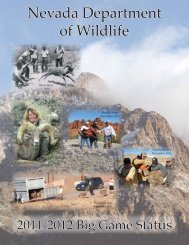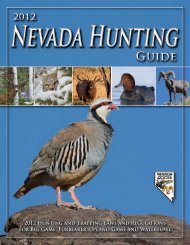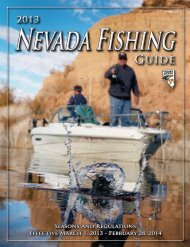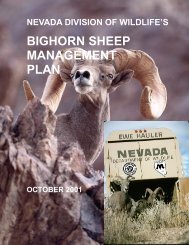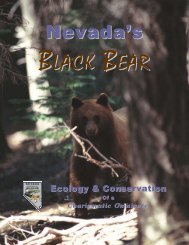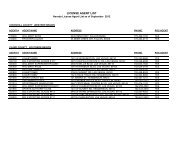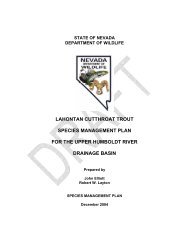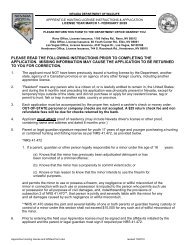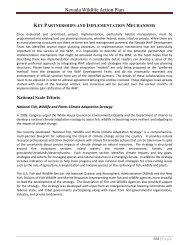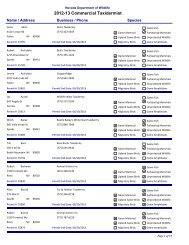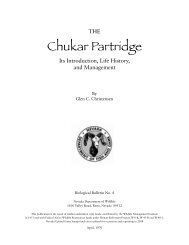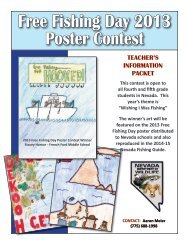Management Plan for Mule Deer - Nevada Department of Wildlife
Management Plan for Mule Deer - Nevada Department of Wildlife
Management Plan for Mule Deer - Nevada Department of Wildlife
Create successful ePaper yourself
Turn your PDF publications into a flip-book with our unique Google optimized e-Paper software.
<strong>Management</strong> <strong>Plan</strong> <strong>for</strong> <strong>Mule</strong> <strong>Deer</strong><br />
Mission Statement<br />
To conserve and improve mule deer habitat and minimize factors limiting<br />
healthy mule deer populations<br />
Purpose<br />
This plan is written to stabilize, and then to reverse, mule deer population declines in<br />
<strong>Nevada</strong>. Without implementation, mule deer and other wildlife populations will continue<br />
to shrink, and the coincident degradation <strong>of</strong> essential habitats will affect the quality <strong>of</strong> life<br />
in <strong>Nevada</strong> and the economy <strong>of</strong> the state.<br />
Executive Summary<br />
<strong>Nevada</strong>ns strongly support the conservation <strong>of</strong> <strong>Nevada</strong>’s mule deer resource as well as<br />
actions that improve the current status <strong>of</strong> populations and habitats. At the same time,<br />
hunters and others present diverse, varied, and sometimes conflicting demands that<br />
challenge mule deer management. The <strong>Nevada</strong> <strong>Department</strong> <strong>Wildlife</strong> (NDOW) has<br />
statutory responsibility <strong>for</strong> the management <strong>of</strong> mule deer and seeks to implement and<br />
promote management actions that positively affect mule deer populations and habitats.<br />
The <strong>Nevada</strong> <strong>Management</strong> <strong>Plan</strong> <strong>for</strong> <strong>Mule</strong> <strong>Deer</strong> (<strong>Plan</strong>) has four objectives. These are<br />
habitat, population management, harvest, and communication/outreach. The <strong>Plan</strong> does<br />
not explicitly address the role <strong>of</strong> law en<strong>for</strong>cement in achieving <strong>Plan</strong> objectives, but game<br />
wardens are the public face <strong>of</strong> NDOW, and active participation by law en<strong>for</strong>cement<br />
personnel is critical to <strong>Plan</strong> success. Also, while the <strong>Plan</strong> does not articulate specific<br />
monitoring objectives, NDOW and the <strong>Nevada</strong> Board <strong>of</strong> <strong>Wildlife</strong> Commissioners<br />
emphasize that habitat monitoring and measuring the response <strong>of</strong> mule deer populations<br />
to different management regimes are essential to accomplishing <strong>Plan</strong> objectives.<br />
Related Documents<br />
NDOW will use this <strong>Plan</strong> to guide population and habitat actions at the <strong>Management</strong><br />
Area and Hunt Unit level. It incorporates by reference the following documents:<br />
●<br />
●<br />
●<br />
<strong>Nevada</strong> <strong>Mule</strong> <strong>Deer</strong> Bulletin (<strong>Nevada</strong>’s <strong>Mule</strong> <strong>Deer</strong>, Population Dynamics: Issues<br />
And Influences (<strong>Nevada</strong> <strong>Department</strong> <strong>of</strong> <strong>Wildlife</strong> Biological Bulletin No.<br />
14, 2004),<br />
<strong>Nevada</strong> Comprehensive <strong>Wildlife</strong> Action <strong>Plan</strong> (<strong>Nevada</strong> <strong>Department</strong> <strong>of</strong> <strong>Wildlife</strong>,<br />
2005) and<br />
North American <strong>Mule</strong> <strong>Deer</strong> Conservation <strong>Plan</strong> (Western Association <strong>of</strong> Fish<br />
And <strong>Wildlife</strong> Agencies, 2004).<br />
Audience<br />
For successful implementation, the <strong>Plan</strong> requires close cooperation among all NDOW<br />
Bureaus, including Game, Habitat, Law En<strong>for</strong>cement, Diversity, and Conservation<br />
1
Education. It also requires that NDOW collaborates with the <strong>Nevada</strong> Board <strong>of</strong> <strong>Wildlife</strong><br />
Commissioners, County <strong>Wildlife</strong> Advisory Boards, and develops strong partnerships with<br />
federal land management agencies and a host <strong>of</strong> other organizations. It presents a<br />
collection <strong>of</strong> issues that confront management <strong>of</strong> <strong>Nevada</strong> mule deer herds, and it lists<br />
corresponding strategies that may assist in issues resolution. The <strong>Plan</strong> recognizes that<br />
because mule deer occupy diverse habitats in <strong>Nevada</strong>, not all strategies will be applicable<br />
to all deer herds. As the science and art <strong>of</strong> mule deer management evolves, other<br />
strategies may be added as the <strong>Plan</strong> is implemented or revised.<br />
The <strong>Plan</strong> is written to assist:<br />
●<br />
●<br />
●<br />
●<br />
●<br />
●<br />
●<br />
●<br />
●<br />
NDOW employees responsible <strong>for</strong> operations on the ground;<br />
NDOW leadership in their oversight <strong>of</strong> operations;<br />
The <strong>Wildlife</strong> Commission in establishing statewide policy and regulation;<br />
Both NDOW and the Commission in seeking Federal and statewide<br />
Legislation and in discussions with local governments;<br />
Both NDOW and the Commission in seeking regulation change <strong>for</strong> other<br />
state and federal agencies;<br />
All land management agencies in developing regulation and policy;<br />
Private landowners;<br />
Sportsmen and other conservation groups attempting to assist NDOW in<br />
mule deer and/or habitat improvement; and<br />
The general public in understanding the habitat requirements and<br />
management strategies implemented to conserve and enhance mule<br />
deer populations.<br />
Implementation<br />
Specific Area <strong>Management</strong> <strong>Plan</strong>s will be developed in accordance with the guidance<br />
provided in this statewide <strong>Mule</strong> <strong>Deer</strong> <strong>Management</strong> <strong>Plan</strong>. These Area <strong>Management</strong> <strong>Plan</strong>s<br />
revised as needed, or on an annual basis, by Game Bureau Field Biologists, and provided<br />
to the Game Bureau Chief in advance <strong>of</strong> the March meeting <strong>of</strong> the <strong>Nevada</strong> Board <strong>of</strong><br />
<strong>Wildlife</strong> Commissioners.<br />
<strong>Department</strong>al Coordination<br />
The successful implementation <strong>of</strong> this plan depends on close coordination among the<br />
various NDOW Bureaus. Accordingly:<br />
●<br />
The Game Bureau Chief will provide annual updates on the development,<br />
implementation and revision <strong>of</strong> Area <strong>Management</strong> <strong>Plan</strong>s derived from<br />
the guidance provided in this <strong>Management</strong> <strong>Plan</strong> <strong>for</strong> <strong>Mule</strong> <strong>Deer</strong>.<br />
Updates will be presented at the March meeting <strong>of</strong> the <strong>Nevada</strong> Board<br />
<strong>of</strong> <strong>Wildlife</strong> Commissioners.<br />
2
●<br />
●<br />
The Habitat, Diversity, and Law En<strong>for</strong>cement Bureau Chiefs will provide<br />
annual updates on their activities in support <strong>of</strong> the guidance provided<br />
in this statewide <strong>Management</strong> <strong>Plan</strong> <strong>for</strong> <strong>Mule</strong> <strong>Deer</strong>.<br />
Implementation <strong>of</strong> this statewide <strong>Management</strong> <strong>Plan</strong> <strong>for</strong> <strong>Mule</strong> <strong>Deer</strong> will be<br />
reviewed at the March 2007 meeting <strong>of</strong> the <strong>Nevada</strong> Board <strong>of</strong> <strong>Wildlife</strong><br />
Commissioners, and at least every 3 years thereafter.<br />
Objectives<br />
Habitat<br />
Habitat is the single greatest factor affecting mule deer density and distribution.<br />
There<strong>for</strong>e, the protection <strong>of</strong> existing mule deer habitats and improvements to poor mule<br />
deer habitat are critical. Here, as elsewhere throughout the <strong>Plan</strong>, the application <strong>of</strong> some<br />
strategies will be based on need, opportunity, and probability <strong>of</strong> success. For example,<br />
“acquisition <strong>of</strong> conservation easements in and around critical mule deer habitat…” and<br />
“acquisition <strong>of</strong> key mule deer habitats from willing sellers…” are purposely provided as<br />
alternatives to development, intended to maintain open space to the betterment <strong>of</strong> mule<br />
deer, and not inconsistent with “traditional uses.”<br />
ISSUES<br />
Urbanization and Development<br />
Increasing human population growth will exert a consistent and largely irreversible<br />
negative impact on mule deer habitats in <strong>Nevada</strong>.<br />
STRATEGY: Acquire conservation easements in and around critical mule deer<br />
habitats from willing participants.<br />
STRATEGY: Acquire key mule deer habitats from willing sellers when feasible.<br />
STRATEGY: Cooperate and coordinate proactively with local municipalities to<br />
assure that mule deer habitat is conserved in land use planning decisions.<br />
STRATEGY: Provide mule deer distribution in<strong>for</strong>mation where appropriate and<br />
promote mitigation.<br />
STRATEGY: Cooperate and coordinate with private landowners to improve,<br />
conserve, and/or protect mule deer habitat wherever willing land owners<br />
have an expressed desire.<br />
STRATEGY: Cooperate and coordinate with private landowners, land<br />
management agencies, counties, road departments and the <strong>Nevada</strong><br />
<strong>Department</strong> <strong>of</strong> Transportation to maintain migratory corridors free from<br />
impediments (fences, roads, etc.) wherever possible.<br />
STRATEGY: Coordinate with county <strong>of</strong> origin and provide in<strong>for</strong>mation on<br />
potential impacts resulting from interbasin water transfers.<br />
STRATEGY: Develop and/or enhance water availability in water limited habitats<br />
to mitigate the effects <strong>of</strong> habitat loss, fragmentation, and degradation.<br />
3
Sustainable Use <strong>of</strong> Public and Private Rangelands<br />
<strong>Mule</strong> deer and other herbivores depend on <strong>for</strong>bs and native grasses throughout the<br />
year, particularly in spring and summer. Landscape scale reductions in these<br />
<strong>for</strong>age plants are having negative impacts on mule deer and other wildlife.<br />
STRATEGY: Prioritize issues by management area.<br />
STRATEGY: Consistently engage land management agencies in mule deer<br />
habitat issues.<br />
STRATEGY: Cooperate and coordinate with federal land management<br />
agencies in land use planning, resource management planning, grazing<br />
plans, fire planning ef<strong>for</strong>ts, energy development lease plans, and other<br />
planning ef<strong>for</strong>ts to avoid or mitigate potentially harmful human impacts on<br />
mule deer and/or mule deer habitat.<br />
STRATEGY: Advocate proactive habitat improvement approaches using best<br />
management practices.<br />
STRATEGY: Develop and distribute a catalog <strong>of</strong> best management practices <strong>for</strong><br />
land management agencies use to optimize meeting nutritional<br />
requirements <strong>for</strong> highly productive mule deer populations.<br />
STRATEGY: Promote appropriate grazing strategies <strong>for</strong> livestock and wild<br />
horses to benefit mule deer habitats (especially riparian areas) and support<br />
federal agency ef<strong>for</strong>ts to manage wild horse numbers at or below AML<br />
(appropriate management level).<br />
STRATEGY: Determine how weather patterns affect mule deer populations in<br />
different <strong>Management</strong> Areas; use this in<strong>for</strong>mation to predict future<br />
population responses.<br />
STRATEGY: Determine relationships among seasonal precipitation, availability<br />
and nutritional quality <strong>of</strong> <strong>for</strong>age, and mule deer population trends.<br />
STRATEGY: Restore areas historically overgrazed by horses and/or livestock<br />
(especially riparian areas).<br />
STRATEGY: Reintroduce <strong>for</strong>bs and perennial grasses in areas with a depleted<br />
understory.<br />
STRATEGY: Greenstrip areas <strong>of</strong> critical mule deer importance to protect from<br />
fire and in the event <strong>of</strong> fire, stress the importance <strong>of</strong> critical mule deer<br />
habitats to fire fighting personnel.<br />
STRATEGY: Develop habitat management plans by management area.<br />
STRATEGY: Evaluate <strong>of</strong>f-road vehicle impacts to mule deer habitats.<br />
<strong>Plan</strong>t Senescence<br />
<strong>Mule</strong> deer are highly selective browsers. They depend on new and easily digested<br />
vegetative growth. <strong>Plan</strong>t senescence throughout <strong>Nevada</strong> rangelands is having<br />
negative impacts on habitat <strong>for</strong> mule deer and other wildlife<br />
STRATEGY: Encourage research to determine the relative nutritional value <strong>of</strong><br />
different species <strong>of</strong> senesced vegetation; prioritize restoration ef<strong>for</strong>ts on<br />
the basis <strong>of</strong> research findings.<br />
4
STRATEGY: Restore plant vigor <strong>of</strong> senesced vegetation through disturbance and<br />
other methods.<br />
Pinyon Juniper Encroachment<br />
Pinyon-Juniper <strong>for</strong>ests provide thermal cover <strong>for</strong> mule deer, but dense stands<br />
reduce understory plant productivity and diversity, increase site aridity, and<br />
accelerate soil erosion. Pinyon-Juniper conditions throughout much <strong>of</strong> <strong>Nevada</strong> are<br />
having negative impacts on mule deer and other wildlife<br />
STRATEGY: Minimize impacts <strong>of</strong> pinyon-juniper encroachment on mule deer<br />
habitat via treatments (mechanical, chemical, prescribed fire).<br />
STRATEGY: Reduce acreages <strong>of</strong> closed canopy pinyon juniper stands.<br />
Invasive Species<br />
Cheat grass and other invasive plants occupy millions <strong>of</strong> acres <strong>of</strong> sage-brush steppe.<br />
They increase fire frequency and out-compete native vegetation. Invasive plants<br />
negatively impact mule deer habitat throughout <strong>Nevada</strong>.<br />
STRATEGY: Prevent the spread <strong>of</strong> invasive and other noxious weeds that<br />
degrade mule deer habitat.<br />
STRATEGY: Implement control programs to eradicate invasive and noxious<br />
weeds whenever practical to improve mule deer habitat.<br />
STRATEGY: Promote research useful to the reestablishment <strong>of</strong> beneficial<br />
vegetation types in burned areas previously <strong>of</strong> critical mule deer<br />
importance.<br />
Wildfire<br />
Fire can benefit or harm the condition <strong>of</strong> <strong>Nevada</strong> rangelands, depending on timing,<br />
elevation, intensity, and frequency. More frequent and hotter fires are having<br />
negative impacts in <strong>Nevada</strong> on habitat <strong>for</strong> mule deer and other wildlife.<br />
STRATEGY: Reestablish beneficial vegetation types in burned areas<br />
<strong>of</strong> critical mule deer habitat.<br />
STRATEGY: Promote research useful to the reestablishment <strong>of</strong> beneficial<br />
vegetation types in burned areas previously <strong>of</strong> critical mule deer<br />
importance.<br />
STRATEGY: Greenstrip areas <strong>of</strong> critical mule deer importance to protect from<br />
fire.<br />
STRATEGY: Coordinate with wildfire incident command personnel to<br />
emphasize mule deer habitat protection in wildfire control.<br />
Type Conversion<br />
Historically, much <strong>Nevada</strong> rangeland was treated to convert native upland plant<br />
communities to crested wheatgrass. Although crested wheatgrass has nutritional<br />
value to mule deer and other wildlife, type conversion has resulted in the loss <strong>of</strong><br />
5
preferred <strong>for</strong>age plants and overall negative impacts on mule deer and other<br />
wildlife.<br />
STRATEGY: Cooperate and coordinate with land management agencies in land<br />
use planning to minimize impacts <strong>of</strong> habitat type conversions resulting<br />
from large scale disturbance.<br />
STRATEGY: Where crested wheatgrass or other exotic vegetation is planted<br />
after fire or other perturbations, work with others to assure that affected<br />
habitats eventually return to native conditions.<br />
Population <strong>Management</strong><br />
Traditionally, NDOW has focused considerable ef<strong>for</strong>t on the survey and inventory <strong>of</strong> big<br />
game populations. This in<strong>for</strong>mation is used to infer habitat health and to make harvest<br />
recommendations. In the absence <strong>of</strong> landscape scale habitat monitoring, mule deer survey<br />
and inventory will continue to be used <strong>for</strong> these purposes. Accordingly, the second<br />
principle objective is to suggest strategies, highlight in<strong>for</strong>mation needs, and plot the<br />
actions necessary to assure practical but science-based management <strong>of</strong> <strong>Nevada</strong> mule deer<br />
herds using the best and most current practices available.<br />
ISSUES<br />
Accurate survey and inventory strategies<br />
Science-based, replicable survey methods are a key to science-based mule deer<br />
population management.<br />
STRATEGY: Evaluate and refine mule deer survey and inventory protocols by<br />
integrating aerial and ground survey technologies.<br />
STRATEGY: Establish objectives <strong>for</strong> management units that meet biological<br />
goals.<br />
STRATEGY: Monitor the effects <strong>of</strong> harvest levels on population demographics<br />
and abundance.<br />
STRATEGY: Use monitoring data to propose and adjust harvest rates, timing,<br />
duration <strong>of</strong> hunts, and quotas to achieve population objectives.<br />
STRATEGY: Monitor adult female survival in representative areas to adequately<br />
describe when and how population change occurs.<br />
STRATEGY: Monitor winter fawn survival in key areas to maintain an accurate<br />
index <strong>of</strong> recruitment.<br />
STRATEGY: Periodically review and delineate seasonal mule deer habitats.<br />
STRATEGY: Use long-term weather data (e.g., snow, lack <strong>of</strong> moisture) to<br />
develop maps <strong>of</strong> critical areas <strong>for</strong> special management under extreme<br />
weather events.<br />
STRATEGY: Identify environmental covariates that may influence survey<br />
accuracy and repeatability.<br />
6
Population health and nutritional status<br />
A variety <strong>of</strong> health and nutritional issues are (or could be) having negative impacts<br />
on mule deer in <strong>Nevada</strong>.<br />
STRATEGY: Develop and sustain surveillance programs <strong>for</strong> diseases that may<br />
affect mule deer.<br />
STRATEGY: Develop and sustain surveillance programs to detect evidence <strong>of</strong><br />
nutritional deficiencies exhibited by mule deer.<br />
STRATEGY: Encourage research to determine plant characteristics (i.e., species<br />
diversity, density, age, distribution) that provide optimal nutritional levels<br />
to sustain mule deer.<br />
STRATEGY: Develop and implement a standard habitat condition index based<br />
on review and summary <strong>of</strong> body condition measures.<br />
STRATEGY: Monitor trends in body condition and correlate with other weather,<br />
habitat, and population parameters to develop predictive models<br />
explaining mule deer population dynamics.<br />
STRATEGY: Develop and sustain rapid response capabilities to investigate<br />
morbidity or mortalities in mule deer populations.<br />
STRATEGY: Implement management strategies, including antlerless hunts, to<br />
prevent or disperse high concentrations <strong>of</strong> mule deer and so minimize the<br />
spread <strong>of</strong> zoonotic disease.<br />
STRATEGY: Develop statistical models to predict the presence, prevalence,<br />
potential <strong>for</strong> spread, and population impacts <strong>of</strong> diseases in mule deer<br />
populations.<br />
STRATEGY: Establish close ties with state and federal agriculture agencies,<br />
human health and environmental agencies to coordinate surveillance,<br />
monitoring, and management <strong>of</strong> diseases and parasites that may cross the<br />
wildlife/livestock and wildlife/human interface.<br />
Minimize factors potentially limiting mule deer populations<br />
Situations exist in which the mule deer population is less than expected in relation to<br />
the available habitat.<br />
STRATEGY: Implement or encourage the implementation <strong>of</strong> research or<br />
adaptive management schemes to determine or resolve differences<br />
between expected population size and habitat resources available.<br />
STRATEGY: Implement predator management when data suggest that mule deer<br />
numbers or population demographics are being negatively impacted by<br />
predators.<br />
STRATEGY: Assess the effectiveness <strong>of</strong> predator management practices and<br />
determine trigger points that would lead to the initiation and termination<br />
<strong>of</strong> predator control programs.<br />
Harvest<br />
<strong>Mule</strong> deer harvest management is a divisive and politically sensitive topic. NDOW has<br />
long emphasized the importance <strong>of</strong> habitat changes and weather conditions as major<br />
7
factors behind population fluctuations, but perhaps may not always adequately address<br />
effects <strong>of</strong> hunting on mule deer abundance and population dynamics. Harvest schemes<br />
are central to mule deer management, and the biological features <strong>of</strong> these schemes are<br />
essential to NDOW mule deer management ef<strong>for</strong>ts and <strong>of</strong> great interest to mule deer<br />
hunters and other enthusiasts. For these reasons, the biological issues related to harvest<br />
and strategies that may be useful in the development <strong>of</strong> <strong>Management</strong> Area specific<br />
harvest recommendations are outlined below. In addition, although individual game<br />
violations are unlikely to affect mule deer populations, collectively they can pose a threat<br />
to the degree <strong>of</strong> success <strong>of</strong> this management plan. For this reason, law en<strong>for</strong>cement is<br />
included as an issue under this plan objective.<br />
ISSUES<br />
Balance competing demands on the mule deer resource<br />
Some mule deer hunters pursue trophy animals while others are more interested in<br />
opportunities to hunt mule deer regardless <strong>of</strong> the probability <strong>of</strong> encountering trophy<br />
bucks. Others are less interested in hunting opportunity than in the knowledge that<br />
mule deer are a healthy part <strong>of</strong> intact ecosystems.<br />
STRATEGY: With the assistance <strong>of</strong> County <strong>Wildlife</strong> Advisory Boards, define,<br />
develop and sustain both trophy and opportunity hunts throughout <strong>Nevada</strong>.<br />
STRATEGY: Implement hunt plans at the <strong>Management</strong> Area and Hunt Unit<br />
level, including the use <strong>of</strong> antlerless (e.g., doe) hunts, to accommodate<br />
the spectrum <strong>of</strong> hunter preferences.<br />
STRATEGY: Assure that hunt plans are consistent with mule deer population<br />
and habitat objectives<br />
STRATEGY: Cooperate with others to implement management practices that<br />
assure mule deer viewing opportunities <strong>for</strong> the public.<br />
En<strong>for</strong>ce laws and regulations<br />
Unlawful take and unethical hunter behavior impact mule deer management<br />
STRATEGY: Regulate and monitor hunters.<br />
STRATEGY: Conduct uni<strong>for</strong>med saturation patrols in documented problem<br />
areas.<br />
STRATEGY: Maximize voluntary compliance with laws and regulations relating<br />
to mule deer protection, management and harvest.<br />
STRATEGY: Promote Operation Game Thief and Unit Watch Programs prior to<br />
and during the mule deer season.<br />
STRATEGY: Promote NDOW coordination on en<strong>for</strong>cement issues, hunter return<br />
cards, season dates, quotas, unit boundaries and maps, tag lists, special<br />
hunts, and special regulations.<br />
STRATEGY: Maximize voluntary compliance with laws and regulations relating<br />
to mule deer protection, management and harvest.<br />
STRATEGY: Solicit cooperation and support <strong>of</strong> private landowners, especially<br />
in problem areas.<br />
8
STRATEGY: En<strong>for</strong>ce compliance with laws and regulations through continuing<br />
emphasis on short and long-term investigations <strong>of</strong> unlawful conduct.<br />
Private Lands <strong>Deer</strong> <strong>Management</strong><br />
Although most <strong>of</strong> <strong>Nevada</strong> is public land, much <strong>of</strong> the best habitat is privately owned. In<br />
order to effectively manage mule deer, it is essential that private land owners are willing<br />
participants in the development and implementation <strong>of</strong> conservation actions. While many<br />
<strong>of</strong> the actions suggested <strong>for</strong> private lands are similar to those appropriate <strong>for</strong> public lands,<br />
there are also important differences.<br />
ISSUES<br />
Minimize land owner-mule deer conflicts<br />
Two benefits <strong>of</strong> working with landowners to resolve conflicts are increased support<br />
<strong>for</strong> mule deer and the development <strong>of</strong> partnerships to conserve and enhance mule<br />
deer habitat.<br />
STRATEGY: Foster dialogue with landowners regarding mule deer biology,<br />
behavior, and habitat requirements.<br />
STRATEGY: Utilize private land hunts, emergency depredation hunts,<br />
antlerless hunts, and/or hazing to remove deer from private lands where<br />
conflict exists.<br />
STRATEGY: Work with landowners to limit or discourage unwanted use <strong>of</strong><br />
agricultural products by mule deer.<br />
STRATEGY: Encourage landowners to maintain migratory corridors.<br />
STRATEGY: Encourage and educate landowners to modify fencing or build<br />
new fences that minimize or avoid impacts on deer.<br />
STRATEGY: Encourage the use <strong>of</strong> innovative programs including volunteer or<br />
honor camp labor to assist willing landowners with fence or habitat<br />
manipulation projects.<br />
STRATEGY: Maintain adjacent public lands in healthy, native, productive<br />
condition.<br />
STRATEGY: Maintain or develop water resources on adjacent public uplands to<br />
reduce mule deer use <strong>of</strong> agriculture lands.<br />
Maximize mule deer habitat suitability <strong>of</strong> private lands<br />
Private nonagricultural land <strong>of</strong>ten has great potential as mule deer habitat.<br />
STRATEGY: Encourage or support projects to create high quality <strong>for</strong>age with<br />
willing landowners.<br />
STRATEGY: Encourage landowners to maintain noncultivated habitats that are<br />
free <strong>of</strong> migratory impediments and provide cover and water resources.<br />
STRATEGY: Maintain and enhance the mule deer damage compensation tag<br />
program.<br />
STRATEGY: Explore legislation to provide funding to enhance habitat <strong>for</strong> mule<br />
deer and other wildlife.<br />
9
Communication and Outreach<br />
Effective communication strategies are essential to maintain and enhance public support<br />
<strong>for</strong> mule deer conservation and <strong>for</strong> the protection and growth <strong>of</strong> essential habitat.<br />
ISSUES<br />
<strong>Nevada</strong>ns are increasingly urban and less likely to understand the habitat<br />
requirements <strong>for</strong> healthy mule deer populations.<br />
STRATEGY: Maximize workshop and other opportunities <strong>for</strong> direct<br />
participation by volunteers in mule deer conservation activities.<br />
STRATEGY: Develop and routinely distribute educational materials that in<strong>for</strong>m<br />
the public about mule deer biology and habitat requirements.<br />
STRATEGY: Develop communication strategies that in<strong>for</strong>m the public about the<br />
number <strong>of</strong> mule deer that can reasonably be expected in different habitats,<br />
and the challenges posed by environmental circumstances (e.g., drought,<br />
heavy snows, invasive species encroachment, and wildfire)<br />
STRATEGY: Develop and provide in<strong>for</strong>mation on practices that may harm or<br />
benefit mule deer populations (e.g., wildlife friendly fencing designs,<br />
supplemental feeding, and optimizing nutritional value <strong>of</strong> native plants)<br />
STRATEGY: Encourage public involvement in gathering and reporting<br />
in<strong>for</strong>mation about unusual incidents involving mule deer, including<br />
instances <strong>of</strong> suspected mule deer morbidity or mortality caused by disease<br />
or nutritional deficiencies.<br />
STRATEGY: Design and conduct scientific surveys to determine the economic,<br />
social, and cultural values <strong>of</strong> mule deer hunting in local communities.<br />
STRATEGY: Design and implement surveys to determine the beneficial aspects<br />
<strong>of</strong> mule deer populations to non-consumptive users.<br />
STRATEGY: Provide mule deer related materials <strong>for</strong> incorporation into<br />
elementary and secondary school curriculums and <strong>for</strong> use by <strong>Department</strong><br />
<strong>of</strong> <strong>Wildlife</strong> in hunter education.<br />
STRATEGY: Create and distribute mule deer related public service<br />
announcements and press releases <strong>for</strong> media distribution.<br />
STRATEGY: Create and distribute news releases on criminal investigations,<br />
successful cases related to mule deer, and other law en<strong>for</strong>cement actions<br />
related to big game (e.g., trespass).<br />
STRATEGY: Provide mule deer related in<strong>for</strong>mation <strong>for</strong> posting on NDOW and<br />
other websites that explains agency policy and the state <strong>of</strong> existing<br />
knowledge about mule deer populations and the factors affecting them.<br />
STRATEGY: Encourage <strong>Department</strong> <strong>of</strong> <strong>Wildlife</strong> participation in educational<br />
activities, and other public <strong>for</strong>ums to provide in<strong>for</strong>mation about mule deer<br />
biology and habitat requirements.<br />
STRATEGY: Promote voluntary mule deer orientation/indoctrination.<br />
STRATEGY: Provide training opportunities <strong>for</strong> NDOW personnel so that<br />
personnel have current knowledge <strong>of</strong> mule deer issues and best<br />
management practices.<br />
10
STRATEGY: Maximize opportunities <strong>for</strong> contact between game wardens and the<br />
public to provide opportunities to distribute in<strong>for</strong>mation about hunting<br />
regulations and the management practices they reflect.<br />
STRATEGY: During uni<strong>for</strong>med patrols, maximize availability and distribution<br />
<strong>of</strong> literature related to mule deer regulations changes.<br />
STRATEGY: Encourage participation by NDOW personnel in special public<br />
contact opportunities, sports shows, conventions, and other events that<br />
provide opportunities to promote voluntary compliance.<br />
Develop effective communication strategies with decision-makers<br />
Many legislators and other decision-makers lack understanding <strong>of</strong> mule deer<br />
population dynamics and habitat requirements.<br />
STRATEGY: Synthesize results <strong>of</strong> data analyses and present to decision makers<br />
at the federal, state, and local levels, both as background and in the context<br />
<strong>of</strong> specific legislative proposals and planning ef<strong>for</strong>ts that may affect mule<br />
deer.<br />
STRATEGY: Regularly prepare and distribute in<strong>for</strong>mation on sensitive topics<br />
such as predation or wild horse management that may influence funding<br />
<strong>for</strong> mule deer conservation ef<strong>for</strong>ts.<br />
Develop and maintain effective interagency communication strategies<br />
Because much <strong>of</strong> <strong>Nevada</strong> is federally managed, it is essential that the <strong>Department</strong> <strong>of</strong><br />
<strong>Wildlife</strong> foster strong working relationships with federal land management agencies<br />
to promote mule deer habitat conservation and enhancement.<br />
STRATEGY: Participate in the development <strong>of</strong> federal land use planning ef<strong>for</strong>ts<br />
to assure that mule deer habitat requirements are considered.<br />
STRATEGY: Participate in federal National Environmental Policy Act processes<br />
when those processes impact mule deer habitats.<br />
STRATEGY: Stress the importance <strong>of</strong> critical mule deer habitats to fire fighting<br />
incident command and planning personnel to minimize habitat loss to wildfire.<br />
<strong>Plan</strong> Evaluation Schedule<br />
The <strong>Nevada</strong> Board <strong>of</strong> <strong>Wildlife</strong> Commissioners intends to use the <strong>Management</strong> <strong>Plan</strong> <strong>for</strong><br />
<strong>Mule</strong> <strong>Deer</strong> as a working document. In order to balance the diverse and evolving needs<br />
expressed by the public during the development <strong>of</strong> this plan, the <strong>Nevada</strong> Board <strong>of</strong><br />
<strong>Wildlife</strong> Commissioners and NDOW will be responsive to new data, ecosystem change,<br />
and public interests. Those wishing to evaluate or modify the plan are invited to contact<br />
the NDOW in writing. Requests will be presented to the Commission as agenda items.<br />
Written or public presentations by members <strong>of</strong> the public may also be made be<strong>for</strong>e the<br />
<strong>Wildlife</strong> Commission. The Commission will review this <strong>Plan</strong> at the March 2007 meeting<br />
<strong>of</strong> the Commission, and at least every 3 years thereafter.<br />
11


